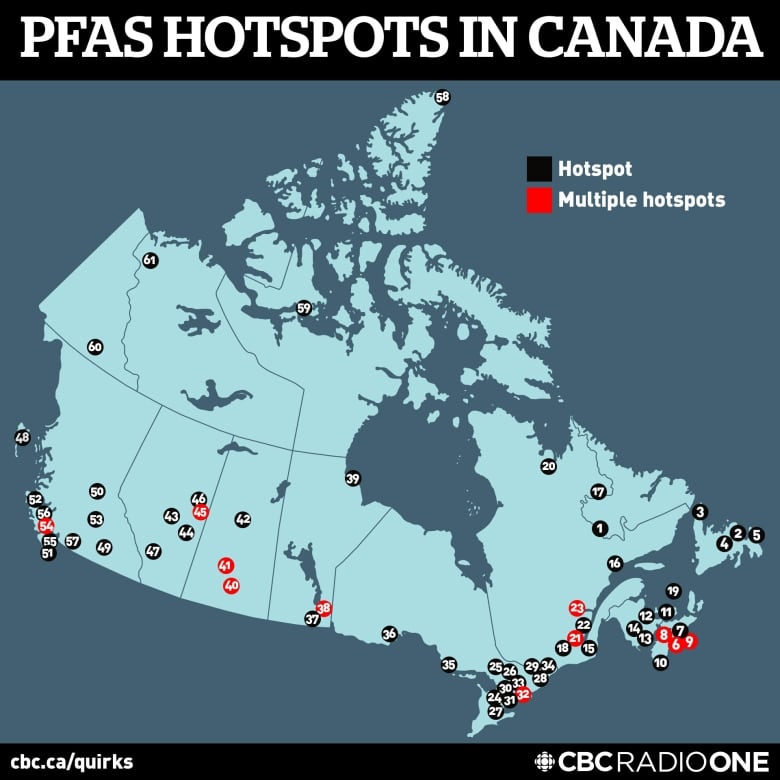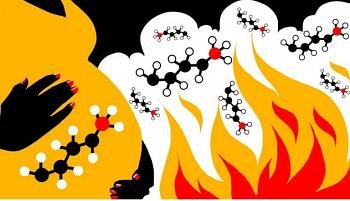'Forever chemicals' can have far-reaching consequences, need more regulation in Canada, scientists say
When Sandy Wynn-Stelt and her husband moved to a Christmas-tree farm in Rockford, Mich., in 1992, they thought they were buying their dream home.
"It was surrounded by Christmas trees," Wynn-Stelt said. "Who doesn't want to live on a Christmas tree farm?"
What they didn't know was that the home of their dreams was on land contaminated by a type of toxic chemical used at a nearby Wolverine footwear factory to waterproof shoes.
The chemical in question is part of a class of widely used chemicals known as PFAS, which stands for per- and polyfluorinated substances. They're sometimes called "forever chemicals" because they last so long in the environment and are found in everything from non-stick cookware to microwave popcorn bags, firefighting foam and stain-repellent fabrics. But their convenience, it seems, could come with a price for the environment and your health.
Several studies have suggested that exposure to some PFAS may be linked to cancer, but research is still emerging on their impacts.
Wynn-Stelt said her husband was, indeed, diagnosed with cancer 24 years after they moved to Rockford and Wynn-Stelt herself underwent cancer surgery to remove her thyroid and surrounding lymph nodes earlier this fall.
"In 2016, my husband was diagnosed with Stage 4 liver cancer and died three weeks later," she said.

Because causal links between PFAS and cancer have not been proven, it's hard to definitely say what role PFAS played in the Wynn-Stelts' cancer. But about a year after Wynn-Stelt's husband Joel died — and following a drinking water advisory for the area around the Wolverine facility — state officials visited her house and tested the well water for chemicals.
When they came back three weeks later with a team in tow, she knew the news wasn't good.
"They told me the rates [of PFAS] in my groundwater at that time were 27,000 parts per trillion, and they thought that was an error because it was too high," said Wynn-Stelt. "So they tested again, and it came back at 38,000 parts per trillion. It's tested as high as 88,000 parts per trillion."
In the United States, the Environmental Protection Agency advises that some common early-generation PFAS be limited to 70 parts per trillion.
Health Canada set the drinking water guidelines for those same legacy PFAS at 1,000 parts per trillion.
The level in Wynn-Stelt's blood was five million parts per trillion — 750 times higher than levels in the average person, she said.
Earlier this fall, Wynn-Stelt underwent cancer surgery to remove her thyroid and surrounding lymph nodes.
The level of PFAS in Wynn-Stelt's blood is considered extremely rare, but most people have at least a small amount. A recent Health Canada biomonitoring study said 98.5 per cent of Canadians have them in their blood.
But PFAS are not well understood here despite the fact that some scientists say a number of these forever chemicals pose significant risk to human health.
What sets these chemicals apart is how stable they are. They're built around two atoms, carbon and fluorine, and the bond that forms between them is one of the strongest bonds possible in organic chemistry.
That means they're hard to break down. It's part of what makes them useful and able to resist oil, guard against water damage and put out fires. And the strength of that bond is why, for so long, it was assumed these chemicals couldn't react with living tissues and, hence, were safe.
It's now clear that's not the case.
'Plethora' of health effects
The amount of these chemicals that enter the body each time you cook with that non-stick pan, or eat a fast-food hamburger wrapped in PFAS-containing paper, may seem insignificant. But the problem is the way these chemicals build up in the body over time. That's because they are bioaccumulative, which means they're absorbed by living organisms faster than the body can break them down and excrete them.
Leading toxicologist Linda Birnbaum, the recently retired director of the U.S. National Institute of Environmental Health Sciences and National Toxicology Program, said PFAS "cause a plethora of effects in multiple tissues, both males and females, many life stages and across the vertebrate kingdom."
The list of diseases and conditions with well-established links to PFAS is long, said Birnbaum, who has a PhD in microbiology and was an adjunct professor at the University of North Carolina in Chapel Hill.
Her catalogue includes:
- Testicular, kidney, prostate and ovarian cancers.
- Ulcerative colitis.
- High cholesterol.
- Pregnancy-induced hypertension.
- Thyroid disruption.
- Hormone changes.
- Liver obesity.
- Immunotoxicity.
- Lower birth weight and size.
- Delayed puberty.
- Decreased fertility.
- Early menopause.
- Reduced testosterone.
- Changes in bone density.
Missing data
But unlike pesticides or pharmaceutical drugs, a significant portion of the more than 6,300 different types of PFAS on the market have little to no data on their use, toxicity and chemical structure and are not currently regulated or restricted in Canada, according to a report by the Canadian Environmental Law Association.
In fact, those details are considered trade secrets.


Location names: Numbers correspond to the locations on the PFAS hot spots map. (Ben Shannon/CBC)
Muhannad Malas, program manager for toxic chemicals at advocacy group Environmental Defence, said there are a number of Canadian regulatory gaps that allow PFAS to enter our environment largely unchecked.
While PFAS are prohibited from being manufactured in Canada, exemptions allow them to be imported as materials in consumer and industrial products, including firefighting foam, said Malas.
But these uses account for most of the problem.
"The exemptions basically exempt the main sources of exposure and releases in Canada," he said.
Legislative gap
Another problem: When a company wants to bring a new product into Canada, the onus is on Health Canada and Environment and Climate Change Canada to determine within just three months if it's safe.
With about 90,000 chemicals used domestically in Canada and the U.S., it's an "unrealistic exercise," said Malas.
We now have several thousands of these PFAS substances that Canada doesn't even know the identity of — and doesn't even have the authority to regulate.
Given chemical companies are the ones with deep pockets, it should be up to the industry to provide enough data for the government to be able to quickly make a decision about its toxicity, he said.
He said the main shortcoming of Canada's approach to chemicals is that it doesn't address the issue of substitution.
"So when we eventually ban a substance or regulate it or restrict it, we haven't done an adequate job … to ensure that the chemicals that replace it are safer chemicals," he said.
"We now have several thousands of these PFAS substances that Canada doesn't even know the identity of — and doesn't even have the authority to regulate.
"That's a very significant legislative gap."
That means Canada doesn't have the authority to know which chemicals are used in which non-stick pan, rain jacket or pair of stain-resistant pants.


Location names: Numbers correspond to the locations on the map showing PFAS concentrations in Canadian surface water. (Ben Shannon/CBC)
Dr. Philippe Grandjean, a professor of pharmacy and environmental medicine at the University of Southern Denmark who studies the effects of toxic chemicals on the body, said Canada's guidelines for those legacy PFAS in drinking water also don't go nearly far enough at 1,000 parts per trillion.
"If you want to protect children against immunotoxicity, you have to go down to a limit of about one part per trillion or below," he said.
Health Canada said in a statement to CBC Radio that in setting drinking-water guidelines, it has "conducted a thorough review of all relevant animal studies and epidemiological studies."
Asked to explain why it hasn't taken a more stringent approach, Health Canada said that although epidemiological evidence has shown an association between the exposure to two common early-generation PFAS and dysfunctions of the immunological system, "it was deemed insufficient to reach a conclusion about a causal relationship."
Arctic inhabitants particularly at risk
Because these chemicals accumulate in the body, concentrations get higher as they move up the food chain, said Amila De Silva, a scientist at Environment and Climate Change Canada, who has a PhD in environmental chemistry.

Amila De Silva, left, and Shane de Solla, a wildlife toxicologist perform water testing at Binbrook Reservoir, also known as Lake Niapenco, outside of Hamilton, Ont. (Sonya Buyting/CBC)
It's one of the reasons why people living in Canada's Arctic, who eat marine animals such as seals and belugas, are among the most vulnerable to PFAS chemicals.
"What's going on in the industrialized nations is having a direct impact on us, on our food, and we are consuming the contaminants. It's on our dinner plates," said Lucy Grey, the Inuit research adviser for the Kativik Regional Government in northern Quebec.
"People were saying, 'Stop eating the belugas.' But you can't really do that either, because now you're taking away the nutritional value. And understand the importance, culturally and traditionally. Then you're going to replace it with what? Store-bought foods that are very expensive?"
You can be in the cleanest place on Earth ... and still, if we scoop up some of that snow, there's PFAS in there.- Amila De Silva
And that's not the only way these chemicals reach people in the Arctic. Ocean and atmospheric circulation patterns deposit pollutants, including PFAS, from elsewhere on the globe to the areas on the planet's two poles.
"You can be in the cleanest place on Earth — the cleanest place on Earth is 2,000 metres above sea level on an ice mountain on Devon Island, and still, if we scoop up some of that snow, there's PFAS in there," De Silva said.
In 2014, Melanie Lemire, an environmental epidemiologist at Laval University in Quebec City, discovered high levels of a certain PFAS in Indigenous children in Quebec's northwestern region.
Since then, she's turned her research attention north to Nunavik, where she and her colleagues conducted a biomonitoring study on PFAS levels in pregnant women.
"Several of these chemicals are very harmful for the development of the child, so that the pregnancy period is a key time for prevention," said Lemire, who holds a PhD in environmental science.
PFAS chemicals can pass the placental barrier to reach the baby and also get into breast milk.
Lemire compared their results from pregnant women in Nunavik to PFAS levels in women around the same age from elsewhere in the country. The pregnant mothers in Nunavik had overall PFAS levels double those of others.
Firefighting hot spots
Every airport in Canada of a certain size is legally required to have a firefighting crew on standby, and those crews have to practice.
But the firefighting foam that airports used exclusively until 2019, and that many likely still use, often contained a cocktail of PFAS chemicals. It was great for putting out aircraft fires. Unfortunately, it was also great at leaching into local groundwater.
There could be as many as 152 to 420 contaminated airports around Canada, according to a 2018 study.
On top of those, military bases are also known to be sources of PFAS contamination. The Canadian Department of National Defence says there are 26 different military properties across the country where PFAS contamination is either suspected or confirmed.

The firefighting foam used by airports until 2019, and many likely still use, often contained a cocktail of PFAS chemicals. (The Associated Press)
Places such as Lac Megantic, Que., where a parked train rolled into town and exploded back in 2013, and Smiths Falls, Ont., where there was a fire at nearby Rideau Valley Marketplace in 2016, are also local PFAS hot spots.
That has implications for the health of people living in these areas whose groundwater becomes affected but also for firefighters.
Back in 2012, Lt. Heather Buren from the San Francisco Fire Department learned of the risk to her and other firefighters stemming from years of direct exposure to PFAS and other toxic chemicals they encounter.
In that year alone, five of her local female firefighting colleagues developed breast cancer.
"I went through the whole process of helping [with] treatment for one of my friends and co-worker firefighter," Buren said. "And it brought her to her knees, and it … made me start to look up and have to turn and face, I guess, you'd really call it a fear. I mean, of course, right, a fear of getting sick and wondering, 'Is my job causing this?'"

In 2012, San Francisco firefighter Heather Buren learned of the risk from years of direct exposure to PFAS and other toxic chemicals encountered in her job. (Submitted by Heather Buren)
San Francisco has more female firefighters than any other major U.S. city. Their rate of developing breast cancer was found to be six times higher than in the U.S. general population. While some studies suggest a link between PFAS exposure and kidney, liver, breast and testicular cancers, proving direct causation is difficult.
"We also know that, among men, rates of certain cancers, including reproductive cancers, tend to be higher among firefighters than the general population," said Rachel Morello-Frosch, a professor at the University of California Berkeley who holds a PhD in environmental health sciences.
Morello-Frosch conducted a study comparing PFAS exposure among female firefighters in San Francisco to those of women who work in offices. She and her colleagues found seven of the 12 PFAS chemicals they were looking for in 70 per cent of the overall study population but 100 per cent of the firefighters, where they were present in higher levels, too.
Heather Buren, far right, with her colleagues. San Francisco has more female firefighters than any other major U.S. city. Their rate of developing breast cancer was found to be six times higher than the U.S. general population. (Submitted by Heather Buren)
So far, Buren remains healthy, but her results from the study were troubling.
"Some of my levels on two or three of the different ones were some of the highest in the studies," she said. "I chuckle, but it's not funny."
Effects on immune response
Although implications for vulnerable groups such as firefighters are severe at any time, the PFAS threat may be particularly pressing during the COVID-19 pandemic.
Dr. Grandjean's studies on toxic chemicals include their effects on immune responses such as those that occur when both children and adults receive routine vaccinations.
Essentially, his research shows exposure to these forever chemicals can hamstring the immune system's response, decreasing the amount of antibodies normally produced.
With the pandemic's arrival, Grandjean and his colleagues began to examine the connection between PFAS chemicals and severe cases of COVID-19.
Their study, which is awaiting peer review, found one PFAS chemical in particular, PFBA, seems strongly associated with severe outcomes. A 2013 autopsy study done in Spain found that the same PFAS chemical seems to accumulate in the lungs.
Grandjean's previous peer-reviewed research also found that PFAS chemicals dampen the antibody response to vaccinations, a troubling possibility as the world waits for a vaccine for the novel coronavirus.
With or without a global pandemic, Muhannad Malas of Environmental Defence said improving our record on forever chemicals will require an update to the Canadian Environment Protection Act — something the group is lobbying the federal government to do.
"I think one of the main issues is that CEPA was written in 1999. And our understanding of how chemicals impact our health was completely different back then," he said. "We need to update the legislation to meet the new science in order for us to be able to deal with those chemicals."
Comments
There are 0 comments on this post








